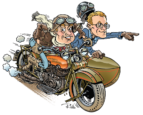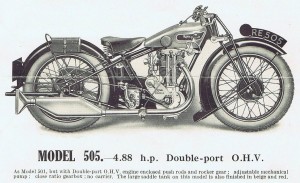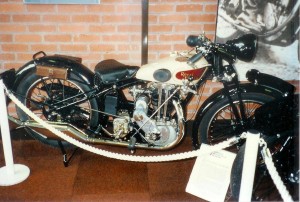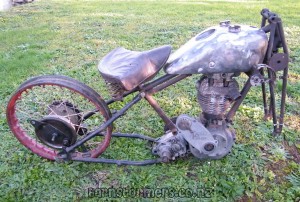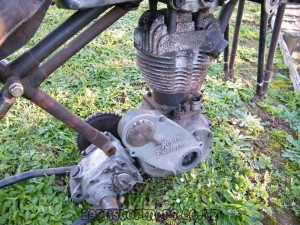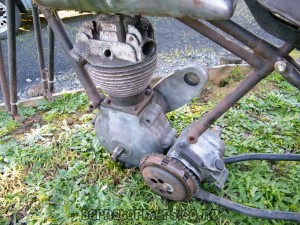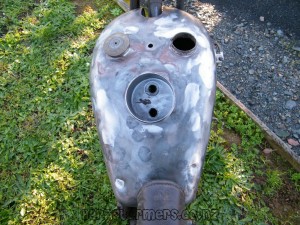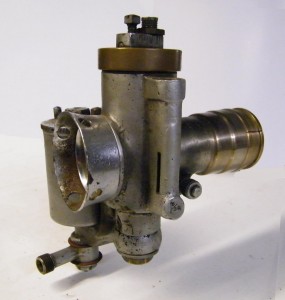Barnstormers is about riding, working on, and reading about old motorcycles. Lately we have been concentrating more on the reading and publishing of old manuals and sales catalogues and so have decided that a change needs to happen. Knobsta suggested a section on polishing but I wouldn’t dare venture into Mrs McShiny’s department (and Knobsta doesn’t polish anyway he just smears) so we both thought that playing with tools seemed the go. We may ride old motorcycles, and we can also be trusted with spanners to pull them apart however reassembly might be another issue so we have devised a plan that involves building (or rebuilding) something old. Initially we were going to use the remains of a 1930 350 Calthorpe however the bike was missing some major major components and was just going to take forever to progress. Next was a 1925 Model OB OHV Douglas but even though it was more complete there are just toooo many moving parts so instead we have decided to go with one of our favourite makes, a Royal Enfield. This is a basic single cylinder machine that consists of a frame, forks, complete engine and gearbox,seat, and a rear wheel. As you can see the bike will be a parts bike special, and so will not be 100% original as parts are hard to come by, but the idea is to create something that could be used on the road and perhaps in the vintage racing class with the Classic Motorcycle Racing Register at places like Hampton Downs and Pukekohe Park race tracks. We won’t be keeping an accurate account of costs as it will not be a true representation of the build. This is because we have access to a reasonably well equipped workshop with a lathe and mill so hopefully few jobs will have to be farmed out, and I will also be using up some of the parts that I have acquired/purchased for jobs over the years that have never happened (like 2 new unpainted 19″ rims that the customer changed his mind on).
When finished hopefully it will ressemble a 488cc OHV Model 505 from 1929.
Unlike the story on the 1930 Royal Enfield (click here for that story) there isn’t one for this motorcycle. It is just an accummulation of parts that came my way after I purchased the OHV engine from a friend in New Plymouth to put in my 1928 Model 501 sv. You would think that the OHV engine would have fitted as both the side valve and OHV machines for that year looked the same. But no, the frame for the OHV is 20mm longer in the front down tube and the rocker gear hit the top rail of the frame on the side valve. The gearbox came from Rotorua, the petrol tank from Auckland, the rear wheel well who can remember but probably from a swap meet, the seat was a good score – it is NOS never been used and was a $40 special from a swap meet again, and the frame from Hitchcocks Motorcycles in the UK in 1996 (I saw it and had to have it). As you can see the parts definitely have travelled some distance just to get here.
Quite ironically Knobsta also owns one of these fine machines, but his one is special (a bit like the ol Knobsta himself) as it has the Royal Enfield factory optional fitted 4 speed gearbox, mine has the standard 3 speed Sturmey Archer gearbox. One could think that these bikes are common but no they were only made for one year (1929) and with the very similar Model E from 1930 there are only about 10 world wide, with 3 being in New Zealand.
A bit of history –
Royal Enfield introduced their first 500 single in 1927 as the side valve Model 500 (the engines were actually 488cc up to the early 1930s). A flat tank machine fitted with Royal Enfields own 4 speed gearbox it wasn’t exactly a slug to ride (click here to see the 1927 sales catalogue description of the Model 500) . By 1928 the Model 500 was upgraded to the Model 501 488sv with the new frame and saddle type petrol tank. However Royal Enfield had reverted back to the Sturmey Archer 3 speed gearbox as standard, offering its own 4 speed gearbox as an optional extra for an additional fee. 1929 arrived and so did the release of their new OHV model, the 505, the machine that we are now rebuilding. 1930 saw a major change in most things Royal Enfield, the first being the change to alpha designations for models instead of numerical designations, so with this the Model 505 was upgraded to the new Model E which was now fitted from factory with lights. 1930 also saw the introduction of Royal Enfields new sloper models with the first of the recirculating oil systems. The Model 505 and Model E were total loss oiling systems.
. . . . . . . . . A 1930 Model E.
This was in the National Motorcycle Museum in Birmingham before the big fire of 2003. The bike was saved but not without damage, however it is salvageable and will be re-restored and put back on display.
.
.
.
.
.
.
.
.
.
The parts we are starting with.
Petrol tank with a hole for the speedo or my case a small lunch pack for those long endurance races.
A nice bit of kit A 1930 AMAL TT30 Racing Carburettor.- Just have to use this!
Along the way we will also be creating a specification sheet on the mechanicals of the 505. This is so that we can keep track of what has been done to the bike including upgrades, and it will also allow us a comparison against what was original spec of the time. This can be a valuable tool especially as we get older and remembering is just not what it used to be. We will update it as the resto progresses.
Order of projects
These are in an approximate order however we will be jumping back and forth as jobs are done and parts become available –
Engine brackets making new brackets as my Model 501 side valve ones are different.
Steering Head Bearings – replacement of bearings and mounting the girder forks.
Rear Wheel mounting the rear wheel including alignment, new rear axle and nuts, respoking, and cush drive
Mounting rear guard stays, fitting, and number boards
Rear stand making one. There is no rear stand for either this nor my 1928 Model 501 so I will be making a period style one. This will involve making fittings and the ‘D’ shaped tube for the legs.
Front wheel respoking, and rebuilding. Currently have not found one but there will be one in a box somewhere.
Brakes front and rear relining and fitting, and making a rear brake operating rod.
Petrol tank and oil tank repairing the petrol tank and mounting, and manufacturing an oil tank.
Engine A full recondition involving stainless valves, new valve guides, hardened valve seats, piston and rings, bigend and main bearings, cams and followers.
Gearbox and clutch rebuilding.
Magneto What do we use? Originally a ML magneto was used but these have suffered badly over time and so to find a good one to rebuild will be difficult. However there are others and we will most likely use a period Lucas item.
Exhaust pipes manufacturing and hopefully a nice pair of fish tail mufflers.
Miscel Quite a big list of small ‘to do’s’ including footpegs, rear brake lever and pivot, handlebars, front race number board mounts, seat, oil lines, cables,
As progress is made there will be numerous nuts, bolts, and studs to be made. Most of these will be stainless and will be either CEI, UNF, or UNC depending on the application. Small brackets that would normally be nickled if replaced will be stainless. As 1929 models were not fitted with lights or any lighting equipment we will be following suit. Instead should we wish to trot the bike around a race track we will be mounting fixtures for number boards and fitting an oil catch tank (a requirement for any race track).
Finally painting and assembly. We have yet to decide on the colour but as per keeping with vintage colour schemes the whole bike will be black with a different coloured petrol tank.
There will be more updates as we progress slowly.
